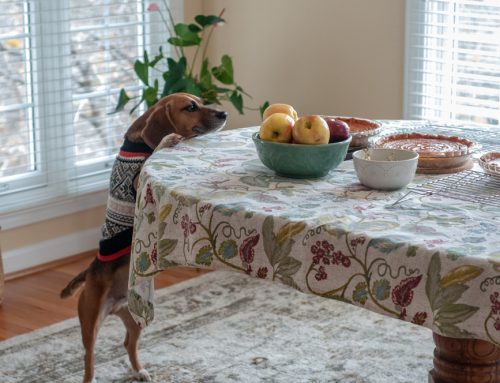Fireworks inspire people to stand up and cheer, but may lead pets to dive for cover or scramble for safety. If the booming, banging, and whistling trigger your pet’s panic, fear, and worry, follow Sale Creek Veterinary Services’ July Fourth tips to help them cope.
Boom and zoom—why some pets fear loud noises
Dogs and cats feel threatened by unpredictable loud noises. Some pets take these sounds in stride when they understand they are not connected to pain or harm, but other pets experience an exaggerated fear response (i.e., phobia) that may include physiological signs (e.g., panting, pacing, shaking, house soiling) and the desire to flee or react aggressively toward the nearest person or pet (i.e., flight or fight).
Noise aversion (i.e., phobia or anxiety) can be associated with any unfamiliar sound, but is most common with unexpected loud noises that include:
- Fireworks
- Thunder
- Gunshots
- Sirens
- Construction equipment
- Everyday appliances (e.g., vacuum, garbage disposal, hair dryer)
While pets’ noise aversion may be genetic, sound sensitivity may be the result of insufficient socialization or a negative association (e.g., having their tail stepped on at the same time the garbage truck arrived).
Intervention—why noise-averse pets need help
Pets’ untreated noise aversion can escalate quickly. In their panic, frightened pets may run away, become disoriented (e.g., bite a familiar person or pet), or act destructively, causing themselves or your property harm.
Noise aversion does not go away on its own, becoming generalized (i.e., vacuum cleaner fear evolves to general household appliance and outdoor sound fear). Ultimately, your pet’s noise aversion can progress to generalized anxiety disorder—a persistent, apprehensive, and agitated state.
Fireworks outside, peace inside—help for your pet
If you know your pet is sound sensitive, follow these recommendations to help keep them calm this July Fourth:
- Visit your veterinary professional — Your pet’s noise sensitivity may be attributable to other health conditions, necessitating a full physical examination. When you visit Sale Creek Veterinary Services, our team will question you about your pet’s behavior, and recommend treatments such as anti-anxiety medications, supplements, and alternative therapies.
While medication is not a long-term noise-aversion solution, these therapeutics can calm your pet, keeping them safe when loud sounds occur (e.g., fireworks celebrations, thunderstorms).
- Create your pet’s safe space — In the weeks leading up to July Fourth, set up a quiet indoor area for your pet, ideally away from windows and doors that lead outside. We recommend a spare bedroom or large bathroom, a place in your home where your pet feels safe.
Make the space cozy and inviting by including your pet’s favorite bed or, if they enjoy napping in the enclosure, their crate. To drown out the loud noises, turn on white noise (e.g., television, radio). Regularly spend time with your pet, so they feel calm and comfortable when they are confined in this space.
- Promote calm and relaxation — Pheromone diffusers or sprays, such as Adaptil for dogs and Feliway for cats, create an atmosphere of peace and contentment. Pheromones are chemical messages pets share that promote security and comfort. Mist your pet’s bedding or a bandana with the spray, or treat the entire room with the diffuser.
In addition, some nervous pets find snug-fitting garments (e.g., the ThunderShirt) beneficial because they reduce anxiety through gentle and steady body pressure.
- Provide positive distractions — If your pet is not prone to destructive behavior, offer hollow rubber toys such as a Kong, WestPaw Toppls, or a lickable mat filled with pet-safe food or treats. To provide your pet long-lasting enjoyment, freeze the toy before serving.
Puzzle toys such as snuffle mats and treat-dispensing balls can distract your pet while providing stimulating entertainment, satisfying them mentally and physically while the thunder rumbles or the fireworks boom.
- Train a new response — A veterinary behaviorist or positive reinforcement-based pet trainer can teach your pet a new emotional response to once-frightening sounds. This process (i.e., desensitization and counterconditioning) involves pairing a low-level stimulus (e.g., a low-volume exploding fireworks recording) with something your pet enjoys (e.g., a treat, petting, praise). When paired with other therapies, desensitization and counterconditioning can permanently solve your pet’s noise aversion.
Sound off—other July Fourth pet safety tips

Of course, fireworks are not your pet’s only July Fourth danger. Prevent Independence Day incidents by watching for these common hazards:
- Heatstroke — When hot weather arrives, keep your pet indoors, and provide plenty of fresh water to keep them from experiencing a potentially life-threatening heat-related injury.
- Water emergencies — Always supervise your pet near pools, lakes, and rivers. No matter how well your dog can swim, a life jacket can protect them if they become exhausted or encounter a strong current.
- Parasites — During the summer, ticks, fleas, and mosquitoes are out in full force. Your pet’s parasite preventives should be up to date so they avoid bug bites’ misery and dangerous disease.
- Gastrointestinal blockage — Corn cobs, meat bones, and food wrappers can obstruct your pet’s intestines, and require emergency surgery. Keep your pet safe—never allow them to eat from your plate.
To ensure an enjoyable holiday for all, keep your pet’s safety in mind when planning your July Fourth celebration. And, if your pet fears fireworks, contact Sale Creek Veterinary Services as soon as possible, so we can establish a plan to help them stay calm and safe before the noise begins.







Leave A Comment